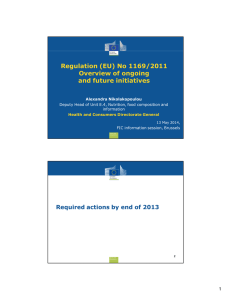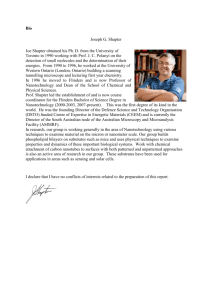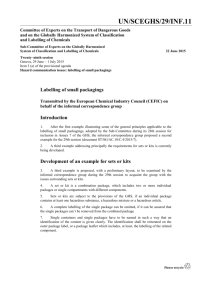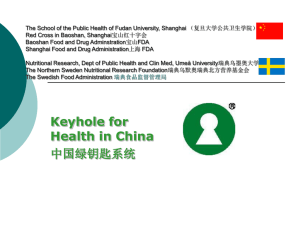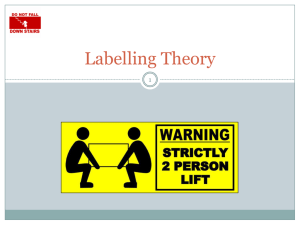Energy Efficiency Appliance Labelling in Vietnam * Summary of
advertisement
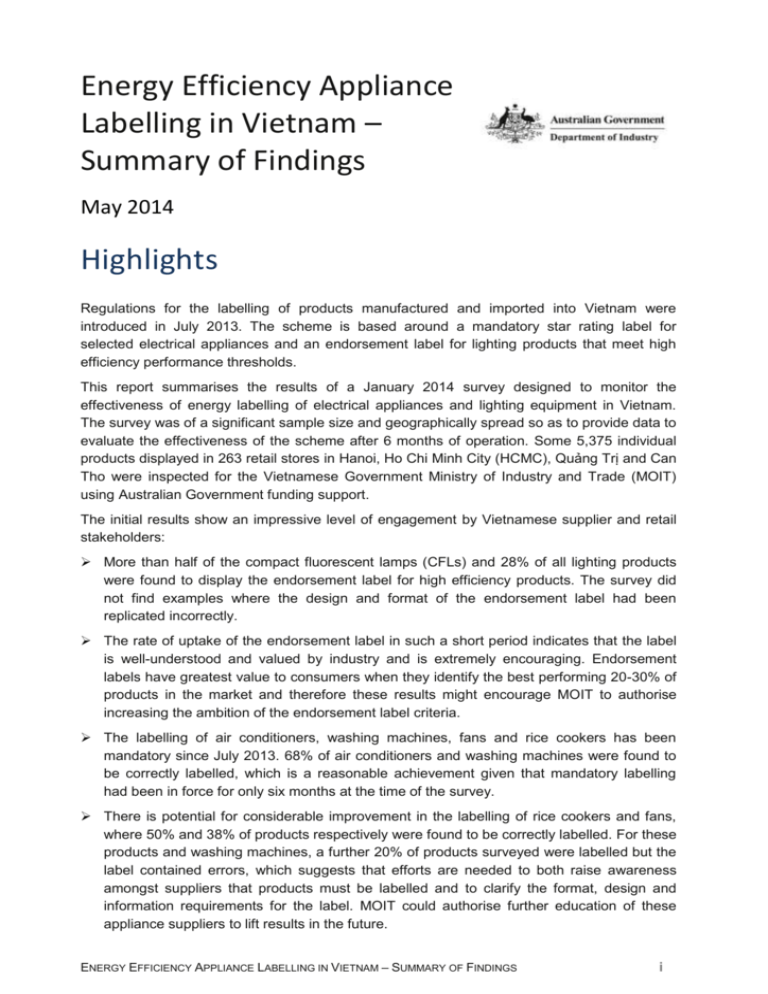
Energy Efficiency Appliance Labelling in Vietnam – Summary of Findings May 2014 Highlights Regulations for the labelling of products manufactured and imported into Vietnam were introduced in July 2013. The scheme is based around a mandatory star rating label for selected electrical appliances and an endorsement label for lighting products that meet high efficiency performance thresholds. This report summarises the results of a January 2014 survey designed to monitor the effectiveness of energy labelling of electrical appliances and lighting equipment in Vietnam. The survey was of a significant sample size and geographically spread so as to provide data to evaluate the effectiveness of the scheme after 6 months of operation. Some 5,375 individual products displayed in 263 retail stores in Hanoi, Ho Chi Minh City (HCMC), Quảng Trị and Can Tho were inspected for the Vietnamese Government Ministry of Industry and Trade (MOIT) using Australian Government funding support. The initial results show an impressive level of engagement by Vietnamese supplier and retail stakeholders: More than half of the compact fluorescent lamps (CFLs) and 28% of all lighting products were found to display the endorsement label for high efficiency products. The survey did not find examples where the design and format of the endorsement label had been replicated incorrectly. The rate of uptake of the endorsement label in such a short period indicates that the label is well-understood and valued by industry and is extremely encouraging. Endorsement labels have greatest value to consumers when they identify the best performing 20-30% of products in the market and therefore these results might encourage MOIT to authorise increasing the ambition of the endorsement label criteria. The labelling of air conditioners, washing machines, fans and rice cookers has been mandatory since July 2013. 68% of air conditioners and washing machines were found to be correctly labelled, which is a reasonable achievement given that mandatory labelling had been in force for only six months at the time of the survey. There is potential for considerable improvement in the labelling of rice cookers and fans, where 50% and 38% of products respectively were found to be correctly labelled. For these products and washing machines, a further 20% of products surveyed were labelled but the label contained errors, which suggests that efforts are needed to both raise awareness amongst suppliers that products must be labelled and to clarify the format, design and information requirements for the label. MOIT could authorise further education of these appliance suppliers to lift results in the future. ENERGY EFFICIENCY APPLIANCE LABELLING IN VIETNAM – SUMMARY OF FINDINGS i While labelling rates were similar for the other three locations, only about half of the appliances in Can Tho displayed the mandatory label. Considering that this city also had the lowest use of the endorsement label, it may be that there is less understanding of the labelling program in this location. MOIT could authorise further work in this region to explain the benefits of the labelling schemes to local stakeholders. The survey results indicate that appliances manufactured in Vietnam are as likely to be correctly labelled as those imported, which indicates the general information programs are working to inform all suppliers of their obligations under the new scheme. The current star rating levels for air conditioners and rice cookers ensure that products in the market span the full range of ratings, providing excellent differentiation and choice for consumers. For both fans and washing machines, almost all models already achieve the highest 5 star rating so there is little differentiation in the market and no incentive for manufacturers to supply better performing products. MOIT could consider authorising a regrading of the rating levels for fans and washing machines because the scheme is working so impressively, so quickly. Survey Description During January 2014, a survey of 5,375 individual appliances and lighting products in Hanoi, Ho Chi Minh City (HCMC), Quảng Trị and Can Tho was undertaken. This survey involved the visual inspection of products in 263 retail stores to ascertain whether models within the scope of regulations displayed the label according to the rules published by MOIT. It should be noted that inspectors were not able to determine whether the energy performance of models match their claim or if the model has been registered with MOIT. The survey included the following eight product categories: compact fluorescent lamps, tubular fluorescent lamps, electronic ballasts, electromagnetic ballasts, air conditioners, washing machines, rice cookers and fans. The distribution of the survey sample by product and location is shown in Figure 1. Figure 1: Distribution of surveyed models by location and product category ENERGY EFFICIENCY APPLIANCE LABELLING IN VIETNAM – SUMMARY OF FINDINGS ii Findings for lighting products In Vietnam, lighting products that meet a specified ‘high efficiency’ level of performance are eligible to display an endorsement label, therefore the aim of the survey was to record the number of lighting products that displayed this label, and whether there were any errors in the replication of this label. 28% of lighting products were found to display the endorsement label although this varied considerably by location: Quang Tri – 39% HCMC – 31% Hanoi – 27% Can Tho - 10% More than half of the CFLs included in the survey carried the label (see Figure 2), suggesting that: Suppliers of CFLs see great benefit from use of the label in order to convince consumers to purchase CFLs rather than cheaper incandescent lamps; There is an opportunity to increase consumer savings by increasing the stringency of the labelling threshold so that the endorsement label identifies the top performing 20-30% of the market. Figure 2: Labelled lighting products by product category Not only is the level of uptake of the endorsement label very encouraging, but the survey did not uncover instances where the design and format of the label had been replicated incorrectly. This may be the result of efforts by MOIT to provide detailed guidelines for suppliers on the design and application of the endorsement label. ENERGY EFFICIENCY APPLIANCE LABELLING IN VIETNAM – SUMMARY OF FINDINGS iii Findings for household appliances Since the household appliances included in this survey have been required by regulation to display a comparison label since July 2013, the aim of the survey for these appliances was to identify products that were either unlabelled or incorrectly labelled. Accounting for all potential offences encountered, 54% of all household appliances in the survey were found to be correctly labelled. As shown in Figure 3, the proportion of correctly labelled products were: Air conditioners – 68% Washing machines – 68% Rice cookers – 50% Fans – 38% Figure 3: Distribution of findings by household appliance category These results show that, while efforts are still required to ensure all products display the energy label, there is large scope for improvement through the further encouragement of suppliers to ensure that their labels display the correct information. Washing machines had the highest rate of labelled appliances, but had a significant number of labelling errors, as did rice cookers and fans. Air conditioners had a large number of unlabelled products but few were found with additional labelling errors. An examination of the survey data indicated the distribution of star ratings across the different products, and the results are shown in Figure 4. The examples of air conditioners and rice cookers included in the survey were evenly distributed amongst the star ratings, so that consumers are provided with choice and there is scope for suppliers to provide models with higher star ratings. ENERGY EFFICIENCY APPLIANCE LABELLING IN VIETNAM – SUMMARY OF FINDINGS iv The large majority of washing machines and fans were found to carry the five star label, which indicates that the thresholds need revising upwards to provide an incentive for the introduction of more efficient products, and to enable consumers to access increased energy savings. Figure 4: Distribution of star rating by product type 38% of labelled appliances were manufactured in Vietnam, with the most common sources of imported products comprising Thailand, China and Malaysia. The origins of appliances do vary by product type, as illustrated in Figure 5, and it is noteworthy that 90% of all labelled fans were locally manufactured. Based on this survey, the labelling compliance rates appear similar for appliances supplied locally and those imported. Figure 5: Origin of products specified on labels by household appliance category ENERGY EFFICIENCY APPLIANCE LABELLING IN VIETNAM – SUMMARY OF FINDINGS v Recommendations Labelling display surveys are regularly conducted through established and new energy efficiency programs in order to monitor the uptake of labelling in the market and highlight potential areas for improvement. Considering that this survey was conducted only six months after the introduction of energy labelling in Vietnam, and the substantial constraints faced in testing and registering products, the results are highly encouraging. It is therefore recommended that: 1. The VEESL team provide briefings to MOIT and DOIT offices in the four survey locations on the findings of this survey. 2. MOIT and DOIT offices in the four survey locations co-ordinate a response to suppliers, providing each in confidence with: a. A summary of the survey report, excluding information on individual brands and stores; b. Details of the results for their models; c. A request to rectify any labelling errors and report back when this has been completed. 3. MOIT and DOIT offices in the four survey locations co-ordinate a response to individual stores included in the survey, providing each in confidence with information equivalent to (2) that is relevant to stores. 4. VEESL should support MOIT to make this survey summary publicly available by funding a translation. In order to improve compliance rates in the future, it is also recommended that: 5. MOIT should clarify the design, format and information requirements for the labels for each product, and ensure that this information is readily available. 6. MOIT should work with VSQI to specify new performance thresholds for the star rating of washing machines and fans; a. MOIT should announce a timetable for the introduction of new labels and the treatment of products already labelled in the market. 7. MOIT should ensure that all retailers are aware that labelling regulations specify that they should not sell products that are required to be labelled if they are not labelled or incorrectly labelled; 8. MOIT should coordinate with all DOIT regional offices to develop an enforcement plan that ensures a consistent approach to the treatment of offences against energy efficiency regulations by suppliers and retailers. 9. MOIT should consider undertaking a further survey within 12 months. Consideration should be given to extending the survey to cover further regions in Vietnam, requiring that all appliances be labelled by this time and to conducting the survey in conjunction with the relevant DOIT offices. ENERGY EFFICIENCY APPLIANCE LABELLING IN VIETNAM – SUMMARY OF FINDINGS vi Disclaimer The authors have made their best endeavours to ensure the accuracy and reliability of the data used herein, however make no warranties as to the accuracy of data herein nor accept any liability for any action taken or decision made based on the contents of this report. ENERGY EFFICIENCY APPLIANCE LABELLING IN VIETNAM – SUMMARY OF FINDINGS vii
